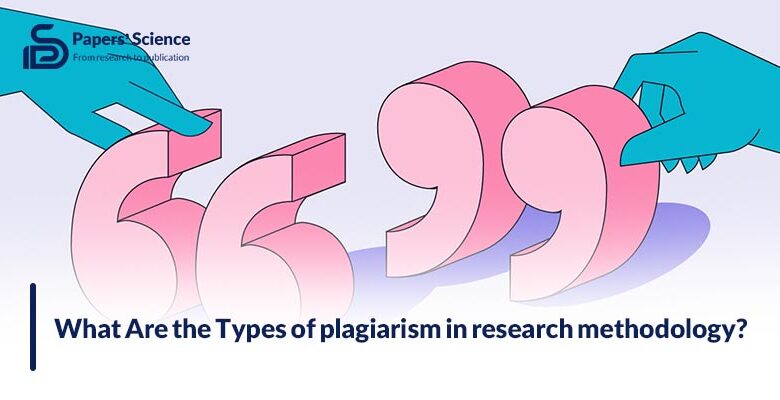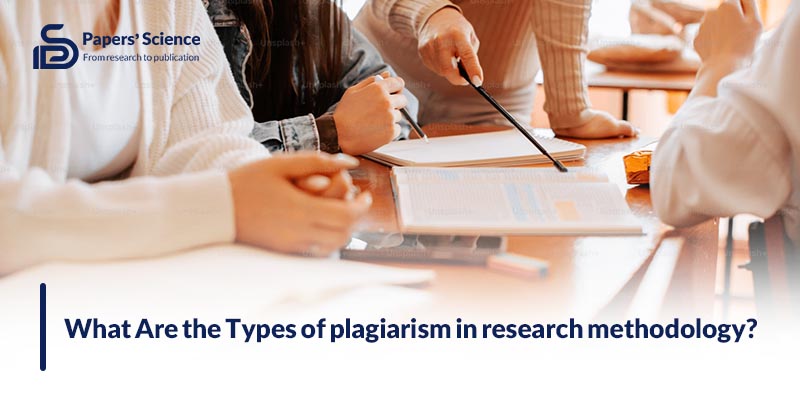What Are the Types of plagiarism in research methodology?

Educational and scientific progress heavily depends on research, which helps expand our understanding and inspire new ideas.
However, this improvement depends on the validity of the research. Plagiarism, uncomplimentary use of someone else’s work, ideas, or words undermines this trust.
As for methods of investigation, plagiarism can take many forms and sizes, each with its drawbacks.
This article examines several types of plagiarism in research methodologies, emphasizing the importance of ethical and moral practices in the classroom.
Types of plagiarism in research methodologies
One of the most common violations of academic ethics is plagiarism. If a plagiarism investigator finds mistakes, your job could be terminated, you could lose employment or funding, and you could lose your reputation in the investigation.
Access to the open Internet can make plagiarism easier to investigate, but that is not always the case.
Some plagiarism expert claim that the correct acts of plagiarism can be even more difficult to understand, especially when information appears to be free and widely available online but still need context.
Knowing what plagiarism is helps you deal with it when writing. So, to continue, let’s be familiar with specific categories of research plagiarism:

1. Direct Plagiarism
The first type of plagiarism in research methodology is Direct Plagiarism.
Academic dishonesty is most evident in outright plagiarism. Researchers transcribe verbatim from the source, presenting it as their own without citations or references.
This type of plagiarism is indisputable and violates intellectual property rights and academic integrity.
This includes direct plagiarism in research papers, dissertations, and presentations.
2. Paraphrasing Plagiarism
The second type of plagiarism in research methodology is Paraphrasing Plagiarism.
To paraphrase the other person’s writing, repeat them in your own words. However, plagiarism occurs when a synonym is too similar to the original to be considered a valid summary. Although it can avoid blatant plagiarism in paraphrasing, it often claims someone else’s words as its own.
3. Accidental plagiarism
Accidental plagiarism is the third type in research methodology that occurs when authors fail to check their work or submit information too quickly.
Failure to acknowledge the source of a cited passage or to place the citation in quotation marks is a serious breach of academic ethics.
Therefore, clerks should review the document before submission to check for plagiarism and prevent it.
4. Inadequate Citation
This part turned to the fourth type of plagiarism in research methodology: Inadequate Citation.
Yes, it is super important to cite your sources when doing research. But it can be considered theft if you don’t do it right.
If researchers do not cite their sources properly or if they do not give credit for ideas, data, or articles, they may accidentally plagiarize.
So, it is important to make sure that everything is taken care of. This can happen when someone doesn’t pay enough attention to details or cites a source and misunderstands the law.
5. Self-plagiarism
The fifth type of plagiarism in research hidden from us is self-plagiarism, so it’s quite common.
It occurs when authors use parts of their previously published works without obtaining the necessary permissions.
Therefore, if you are working on a research paper, it is a good idea to go for a plagiarism check to catch and prevent self-plagiarism.
6. Mosaic plagiarism
The other challenging type of plagiarism in research is mosaic plagiarism.
Because it incorporates the words or phrases of another person into its investigation, mosaic plagiarism might be more challenging to identify.
This kind of plagiarism, also known as patchwork plagiarism, is done intentionally and is dishonest.
7. Complete Plagiarism
The most serious kind of plagiarism is known as “complete plagiarism.”
This occurs when a researcher submits an article or study that was authored by another person but uses their name on it. It is the same as stealing money or stealing intellectual property.
8. Data Plagiarism
Plagiarism in data is the last type of plagiarism in research refers to the act of copying or using someone else’s research data such as tables, figures, or charts, which is not well accepted because the data is such an important part of research, that it is misused or plagiarized.
Read More: How Much Does It Cost to Publish a Research Paper?
Conclusion
The legitimacy of the scientific and academic community and the development of its knowledge depends on the credibility of the research being conducted.
Plagiarism, in general, is a serious threat to academic integrity. Scientists must take great care to adhere to ethical guidelines and to give appropriate credit to others for their work.
Minimal levels of plagiarism in research methodologies and consistent work on academic integrity are essential to ensure that knowledge-seeking is always a moral and honorable endeavor.

So, what is your idea about plagiarism in research methodologies? Have you faced this problem up to now in your research? Share your experiences with us in the comment section.
Direct plagiarism is one of the most blatant forms of academic dishonesty. It involves copying content verbatim from a source and presenting it as your own work without proper citations or references. This type of plagiarism violates intellectual property rights and academic integrity.
Paraphrasing plagiarism occurs when researchers attempt to rephrase someone else’s work but end up using synonyms that are too similar to the original text. This makes it difficult to distinguish from the original source, leading to claims of someone else’s words as their own.
Accidental plagiarism happens when authors fail to properly cite their sources or neglect to use quotation marks for direct quotations. To prevent accidental plagiarism, it’s crucial to review and double-check your work before submission to ensure proper citation and attribution.



